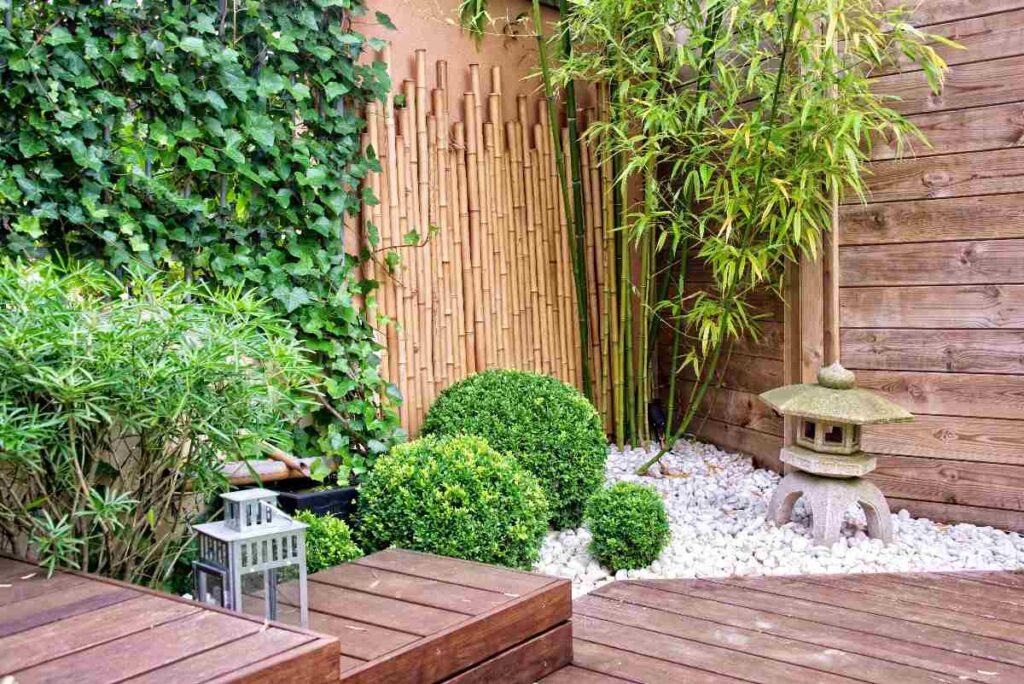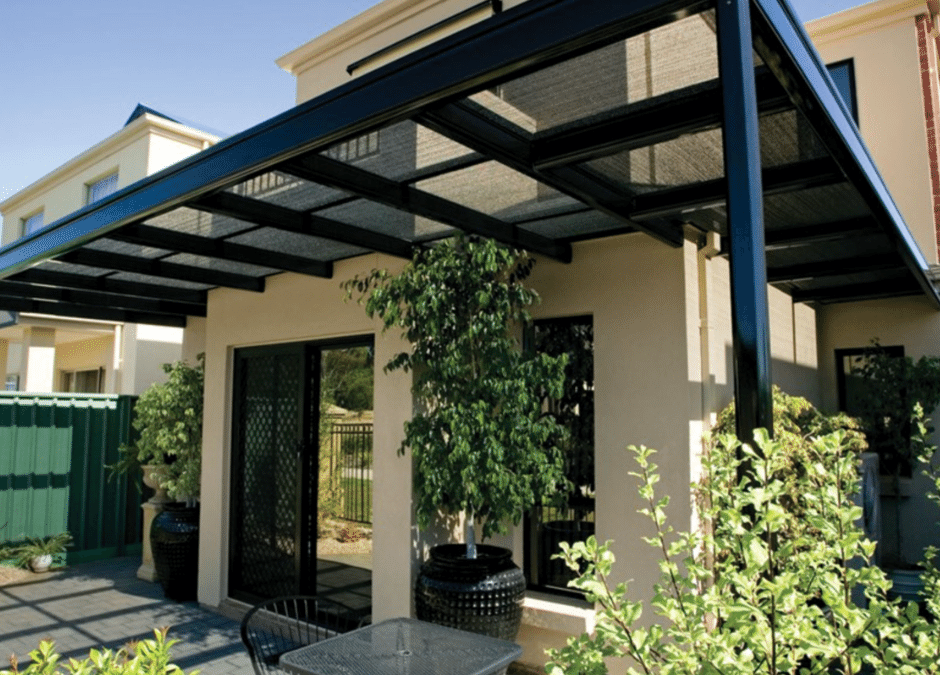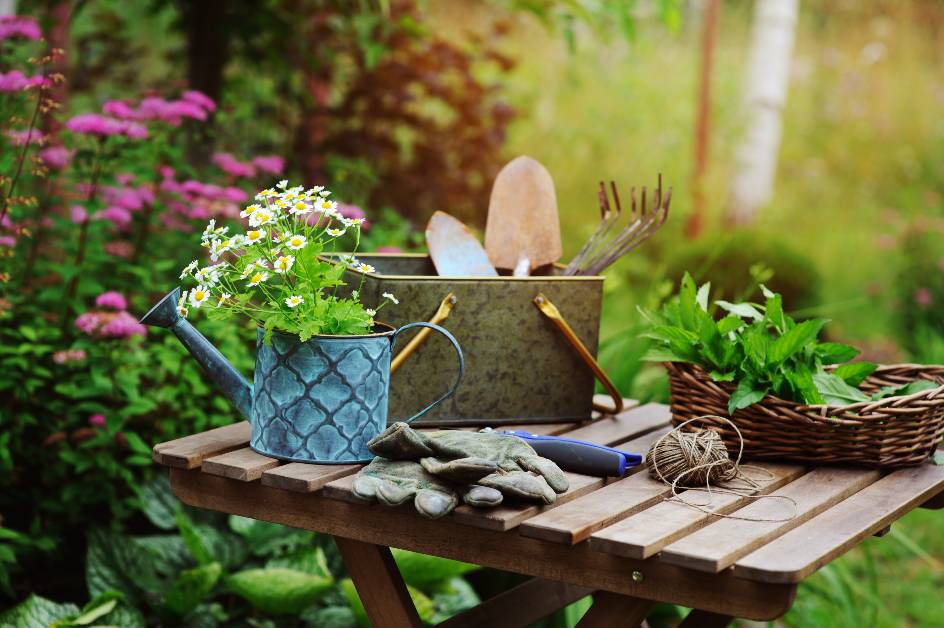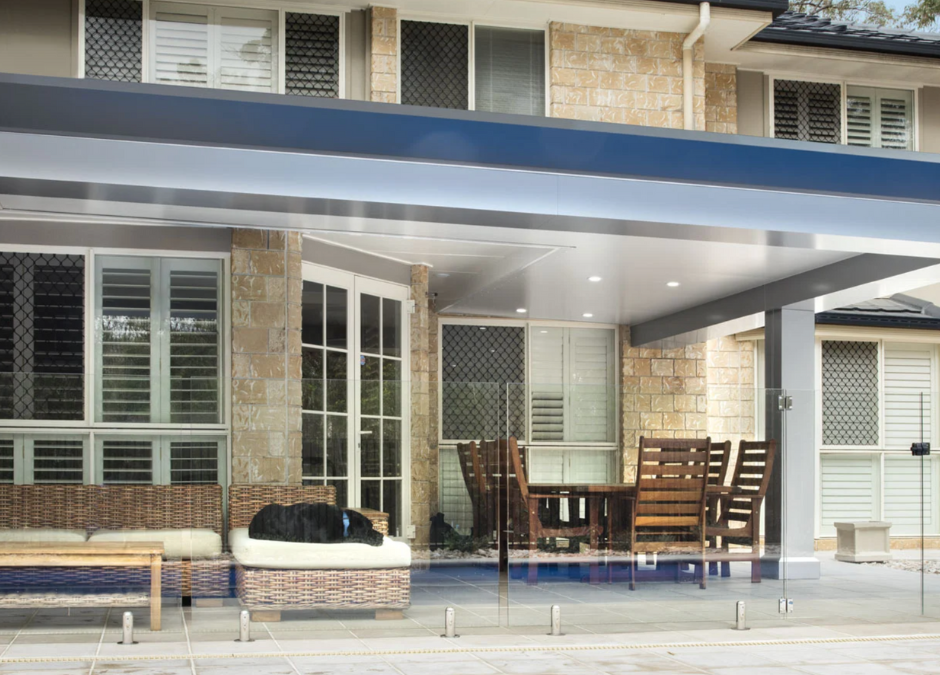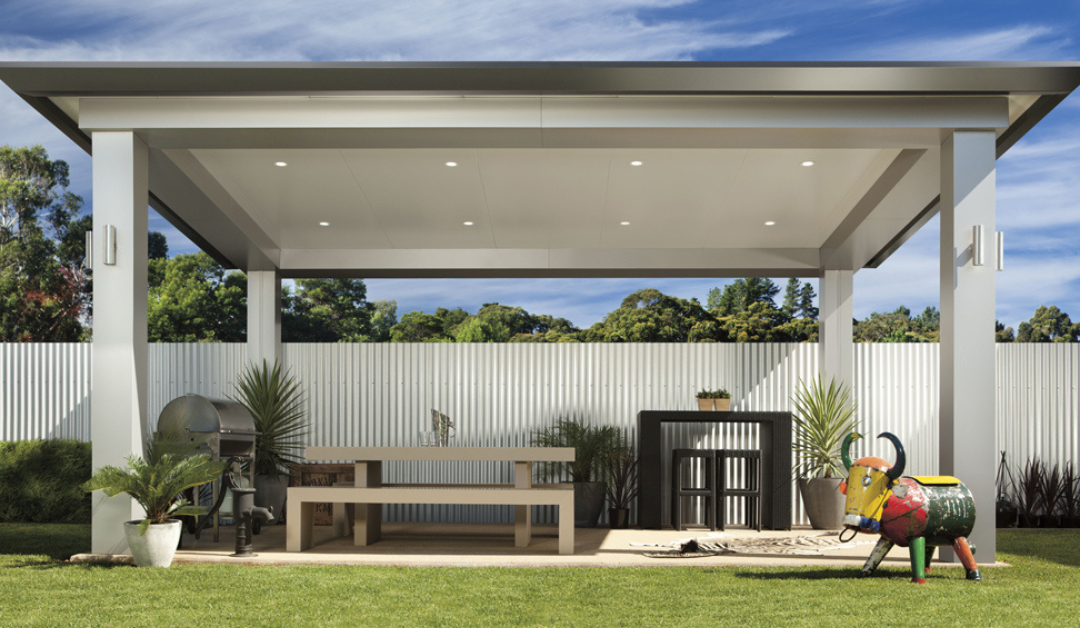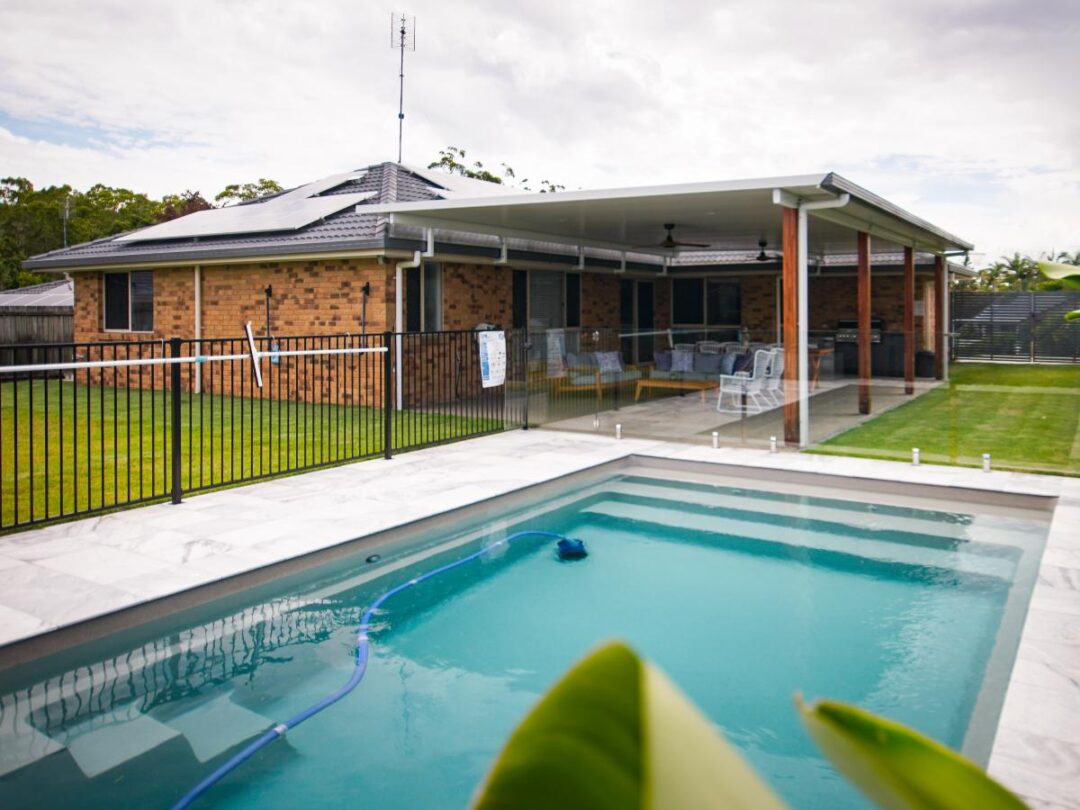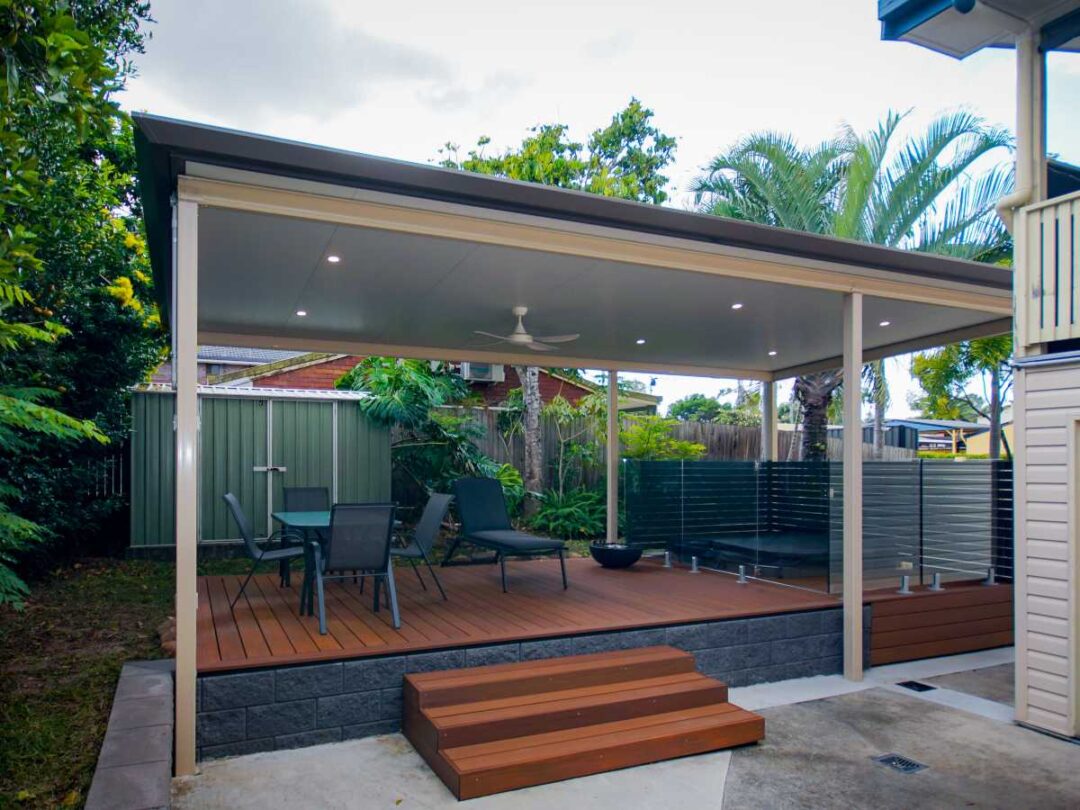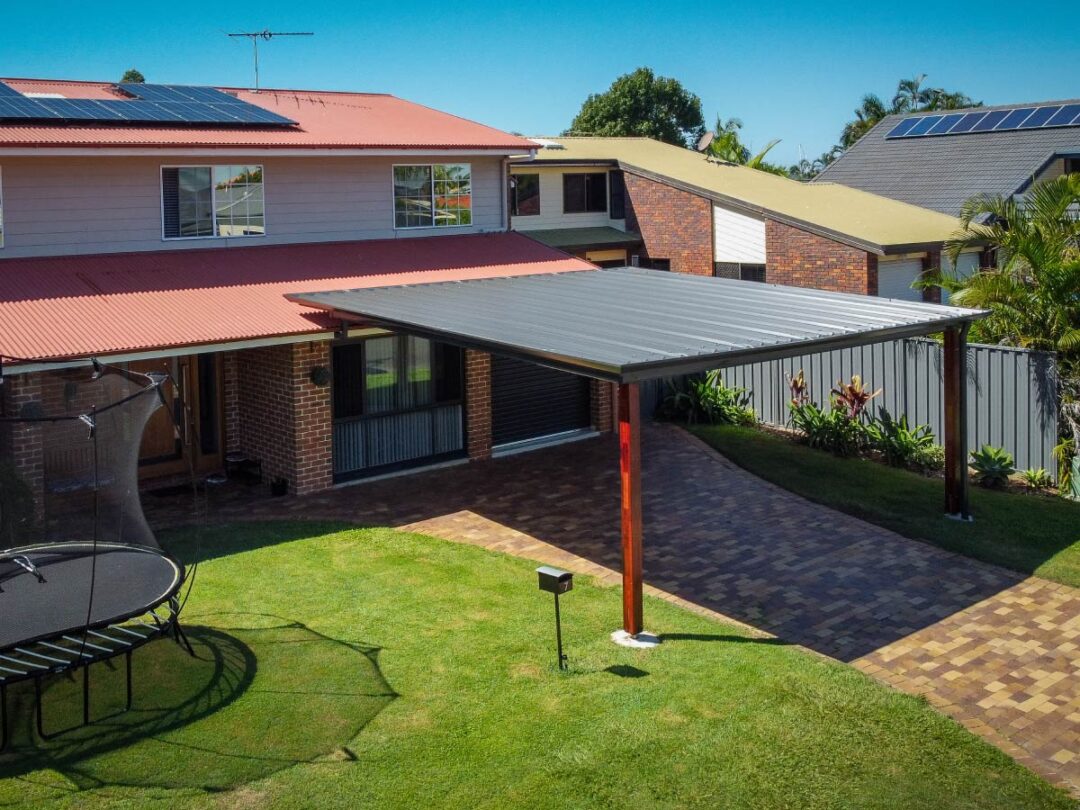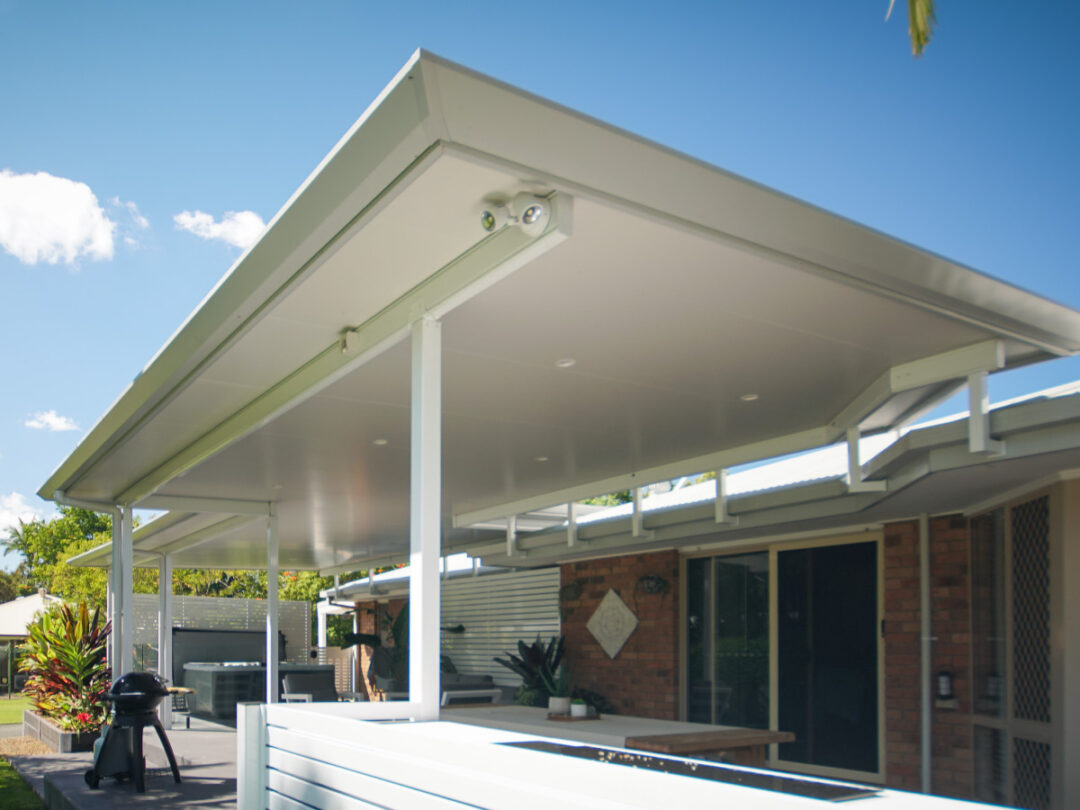If you’ve always admired the serene Japanese gardens that you’ve seen in photos and films, with their clean lines, tranquil koi ponds, and elegant pagodas, this article is for you. In this guide, we’ll walk you through everything you need to know to design your own Japanese-inspired patio paradise, from choosing the right plants and features to arranging them in the right way. With a few simple tips, you’ll be well on your way to creating a peaceful oasis filled with the sights, sounds, and spirit of the Land of the Rising Sun.
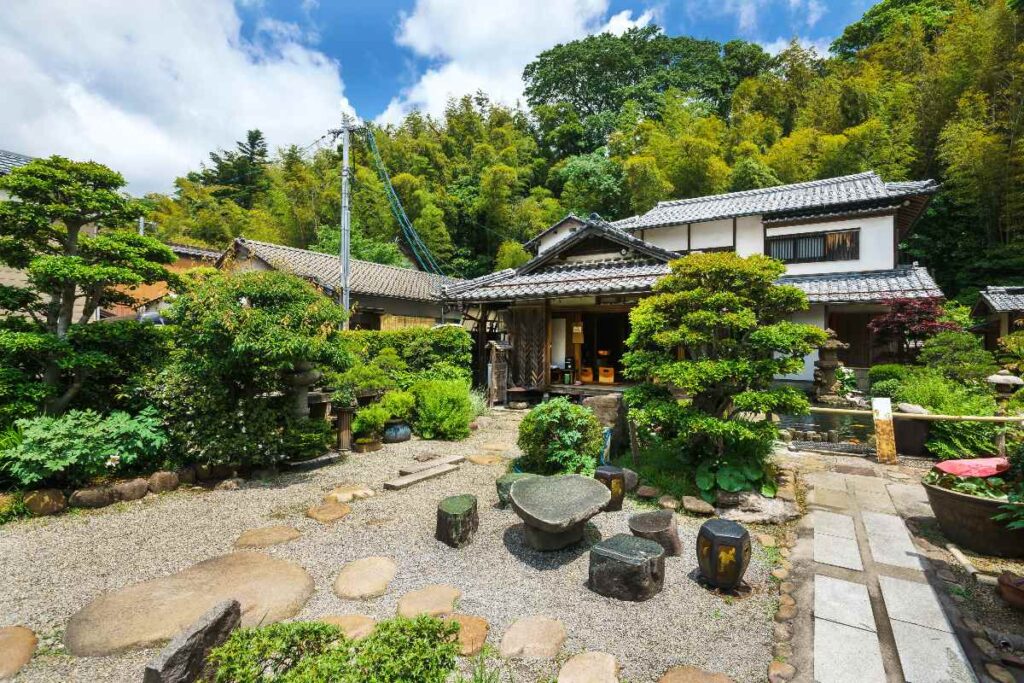
Embracing Japanese Aesthetics for Your Patio
To achieve a Japanese-inspired patio, focus on minimalism, natural elements and tranquilly.
Create a Simple Space
If you’ve already got a patio area, be sure to keep furnishings to a minimum. A small table and a few chairs are all you need. Remove any unnecessary decorations and knickknacks. A clean, uncluttered space is peaceful and calming.
Use Natural Materials
Incorporate natural stone, wood and plants. A wooden deck or stone pavers are ideal for flooring. Wooden furniture with clean lines complements the style. Potted plants, trees, and a small zen garden help bring nature in.
Add Subtle Touches
Include a stone lantern, bamboo fencing or a small water feature. Their gentle presence helps evoke a sense of serenity.
Keep it Balanced
A balanced, harmonious layout is key. Position furniture and features symmetrically for a sense of order and tranquillity. Group items in odd numbers, like three potted plants or five stones. Leave negative space around the edges of your patio for an uncluttered feel.
With some simplicity, natural elements and balance, you’ll have a patio oasis perfect for relaxation and meditation. Now all that’s left to do is sit back, unwind, and soak in the peaceful ambience you’ve created.
Merging Australian Outdoor Trends with Japanese
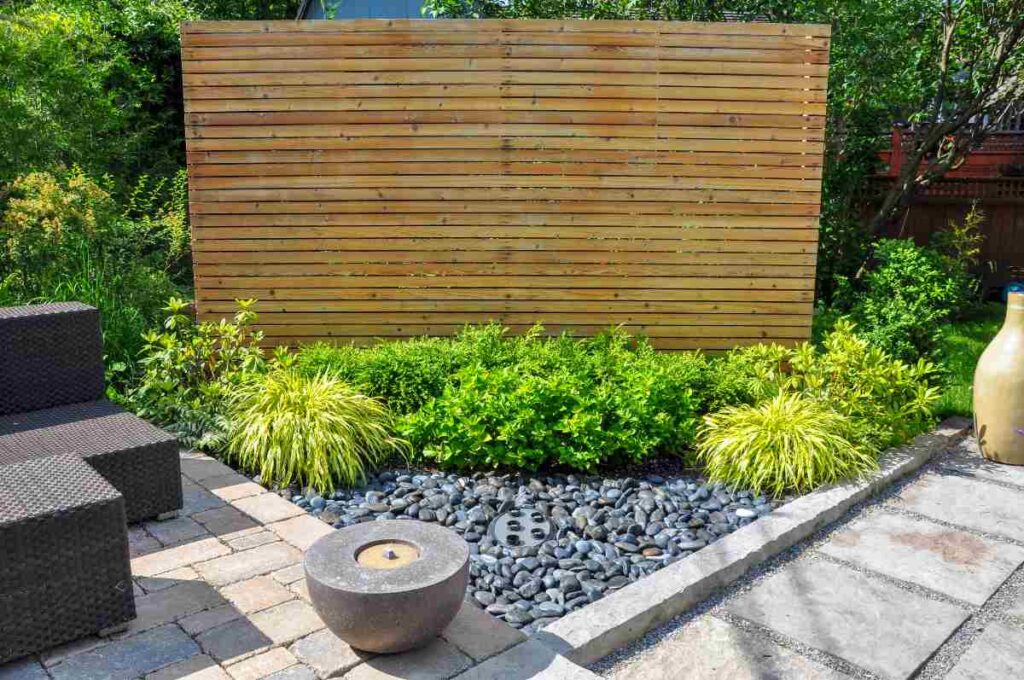
Australia’s outdoor living values can be quite different from Japanese. One example is our love of outdoor socialising, hosting and relaxing, which is why outdoor shade like patio covers, pergolas and verandahs are commonplace in so many Aussie homes. While the ideal Aussie home has a big yard and a deck to match, Japan’s smaller block sizes mean you’ll scarcely find one with a big lawn space. Oftentimes, when Australians look to Japan for inspiration, we focus on more rural gardens that have a bit more land to play with than compact metro homes. Still, Japanese gardens are great at sectioning off areas for intentional use instead of just having a sprawling turf lawn that hardly sees any use. Because of that, owners of large and small properties have been looking to the east to find inspiration for their garden spaces.
Mixing Aussie outdoor vibes with Japanese garden flair is like blending the best of both worlds. Think big Aussie backyard parties with a splash of Zen tranquillity. Imagine sprawling decks dotted with minimalist rock gardens and cozy seating nooks where you can kick back with friends or find a moment of peace amid the hustle. It’s all about creating a space that’s perfect for both lively gatherings and quiet reflection, giving your outdoor area that unique blend of Aussie fun and Japanese serenity.
Japanese-Style Outdoor Shade Options
View this post on Instagram
In Japanese gardens, you’ll often find simple open-air structures like pergolas and gazebos, offering a cozy spot for sheltered relaxation. These structures provide a serene setting for unwinding, meditating, and reconnecting with your inner Zen. Additionally, they’re perfect for hosting guests and enjoying the peaceful view of your surrounding landscape. While Japanese garden architecture may not employ features like patios and verandahs in the same manner as Australians do, their incorporation of pagodas and other open-space structures offers a pathway to achieving a similar aesthetic using Australian options. 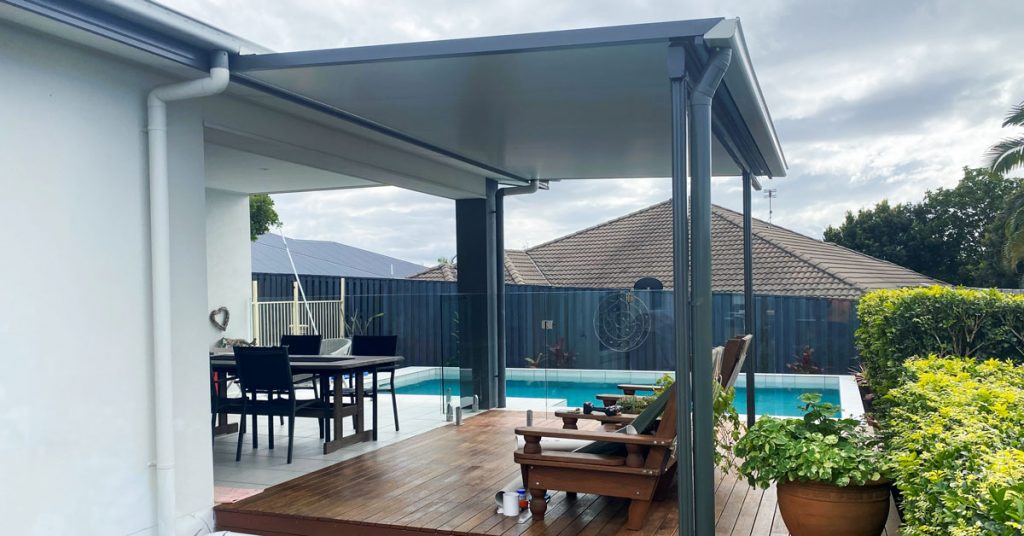 Outdoor structures play a big role in creating harmony with nature. For instance, a patio or verandah can be designed with clean lines to create a minimalist aesthetic reminiscent of traditional Japanese architecture. Pergolas can be adorned with climbing plants like wisteria or jasmine, evoking the lush greenery found in Japanese gardens while still utilising structures that are commonplace in Australia.
Outdoor structures play a big role in creating harmony with nature. For instance, a patio or verandah can be designed with clean lines to create a minimalist aesthetic reminiscent of traditional Japanese architecture. Pergolas can be adorned with climbing plants like wisteria or jasmine, evoking the lush greenery found in Japanese gardens while still utilising structures that are commonplace in Australia.
Pavers and Zen Gardens
 One of the most notable differences between Australian garden trends and Japanese gardens is the former’s love of turf. Large spaces of lawn are replaced with cultivated features such as mossy mounds, intricately paved areas, and meticulously raked Zen gardens. While the Australian landscape often showcases vast stretches of greenery, Japanese garden design embraces a more intimate and purposeful approach, focusing on creating tranquil spaces that evoke a sense of harmony and balance with nature. In lieu of traditional lawns, Japanese gardens emphasise the beauty of simplicity, utilising mounds of moss, flats of gravel, and stone arrangements to evoke a serene atmosphere conducive to contemplation and inner peace.
One of the most notable differences between Australian garden trends and Japanese gardens is the former’s love of turf. Large spaces of lawn are replaced with cultivated features such as mossy mounds, intricately paved areas, and meticulously raked Zen gardens. While the Australian landscape often showcases vast stretches of greenery, Japanese garden design embraces a more intimate and purposeful approach, focusing on creating tranquil spaces that evoke a sense of harmony and balance with nature. In lieu of traditional lawns, Japanese gardens emphasise the beauty of simplicity, utilising mounds of moss, flats of gravel, and stone arrangements to evoke a serene atmosphere conducive to contemplation and inner peace.
Design Elements for a Japanese-Inspired Garden
Simplicity is key
Keep things simple and avoid clutter. Focus on a few high-quality elements like a stone lantern, bamboo fountain or tiny Zen garden. The minimalist vibe creates a sense of calm.
Natural materials
Use natural stones, gravel, wood and plants. Rocks, pebbles and boulders are ideal for paths, borders and accents. Timber works well for benches, fences and gates while bamboo is perfect for fountains and wind chimes.
Asymmetrical balance
Japanese gardens have a very natural feel so go for an asymmetrical layout. Vary the heights of plants and place focal points off-centre for a dynamic, unstructured composition.
Winding paths
Create curving paths instead of straight lines. Pebble paths that meander through the garden are typical. They guide visitors on a journey of discovery while also giving the impression of a larger space.
Water feature
The gentle trickle of water helps create a sense of peace. Even a small fountain or waterfall can make a big impact. Locate your water feature in a position where the sound will carry throughout the garden.
Pruning
Bonsai and Topiary show how the Japanese art of pruning can shape plants to highlight their natural beauty. Prune plants in your garden to sculpt them and bring out their essence. Simple yet sophisticated, a Japanese-inspired space should evoke feelings of tranquillity and connection with nature. By keeping the design uncomplicated and using natural materials, you’ll craft an outdoor oasis ideal for relaxation and reflection.
Plants and Features to Include in a Japanese Patio
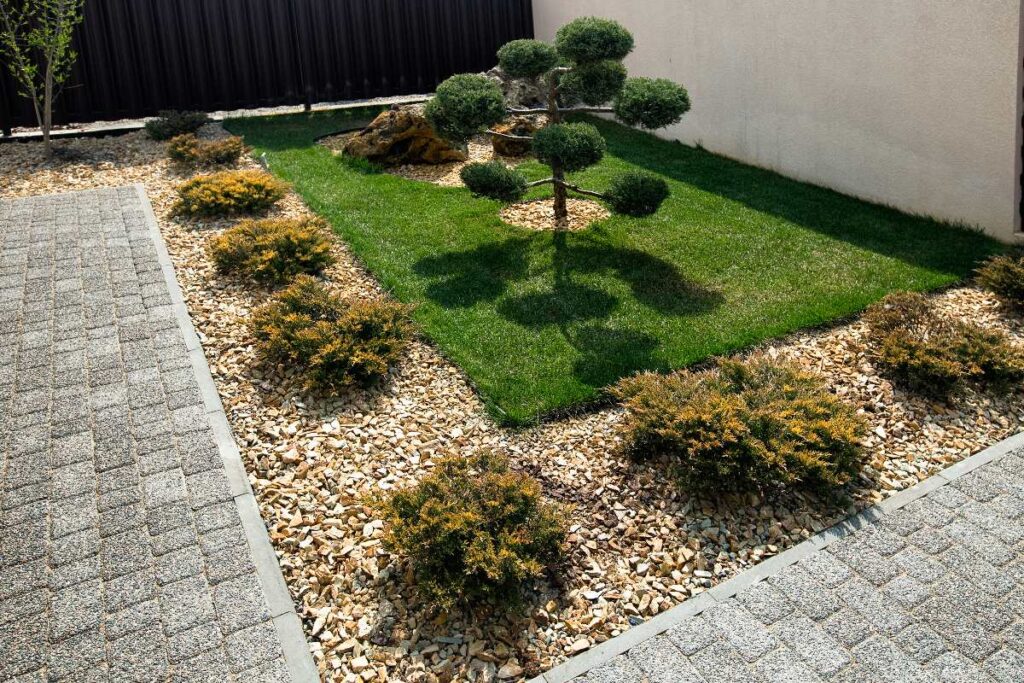 A Japanese patio design incorporates classic plants and features that evoke a sense of minimalism and tranquillity.
A Japanese patio design incorporates classic plants and features that evoke a sense of minimalism and tranquillity.
Bonsai
No Japanese garden is complete without bonsai trees. These miniature trees represent the harmony between nature and humans. Choose varieties like azalea, juniper or maple. Place a grouping of three or five bonsai in a shallow pot for maximum impact.
Bamboo
Bamboo is an important element in Japanese garden design. Its tall, thin stalks provide height and visual interest. Plant bamboo in a container or directly in the ground, depending on the species. For small spaces, try dwarf bamboo varieties. Note, Bamboo is notoriously difficult to control, so unless you have ample room to facilitate growth, we recommend limiting your growth to pots.
Moss
Moss thrives in shady, humid environments and is a signature of Japanese gardens. Its soft green carpet creates a lush ground cover and transition between hardscape materials. Mosses grow on rocks, paths and in between pavers. To establish moss in your patio, find a shady, moist area and scatter moss fragments over the soil. Keep the area damp until the moss takes root.
Water feature
The gentle trickle of water helps create a serene ambiance. Add a small fountain, waterfall or koi pond. For patios, a tabletop fountain or bubbling urn work well. The sight and sound of moving water helps transport you to a peaceful, natural setting.
Lanterns
Stone or bamboo lanterns artfully dot the patio, illuminating pathways in the evening. Their soft glow enhances the calming, meditative feel of a Japanese-inspired space. For safety, use LED candles or spotlights inside the lanterns. These classic elements work together to make a Japanese-themed patio feel authentic yet livable. Keep things minimal and let the natural materials shine through for a perfectly zen outdoor oasis.
Material Selection – Decor Touches to Add Zen to Your Outdoor Space
When designing a Japanese-inspired patio, choose natural materials.
Stone
Natural stone like slate, granite and sandstone make ideal flooring and path materials. Their earthy tones and textured surfaces create a rustic yet elegant look. For seating, large stone boulders make a simple Zen statement.
Wood
Timber boards, bamboo fencing and wooden decking are all perfect for a Japanese patio. Cedar, redwood and teak are durable, weather-resistant options. Wood adds warmth while still keeping the space minimal.
Water
The sound and sight of moving water helps create a peaceful ambience. Add a small waterfall, koi pond or fountain. Bamboo spouts and stone basins are traditional but contemporary styles also work well.
Bamboo
The hollow wood and rustling leaves of bamboo evoke a sense of solitude and calm. Plant bamboo in a secluded corner or use cut bamboo pieces as fence panels or to make a small gate. Bamboo mats, screens and fencing are also great for adding instant privacy and seclusion.
Sand or gravel
Rake sand or gravel into patterns to represent the flow of energy or a zen garden’s rippled water effect. Start with a circle, spiral or wave and rake from the centre outwards using a bamboo rake. Smooth the surface with each stroke. The meditative process of raking and the transient nature of the patterns created embody the zen philosophy.
Keeping these touches minimal and balanced, while focusing on natural and impermanent materials will help create an inviting outdoor space for solitude, meditation and finding your own zen.
FAQs on Building a Japanese Zen Garden Patio
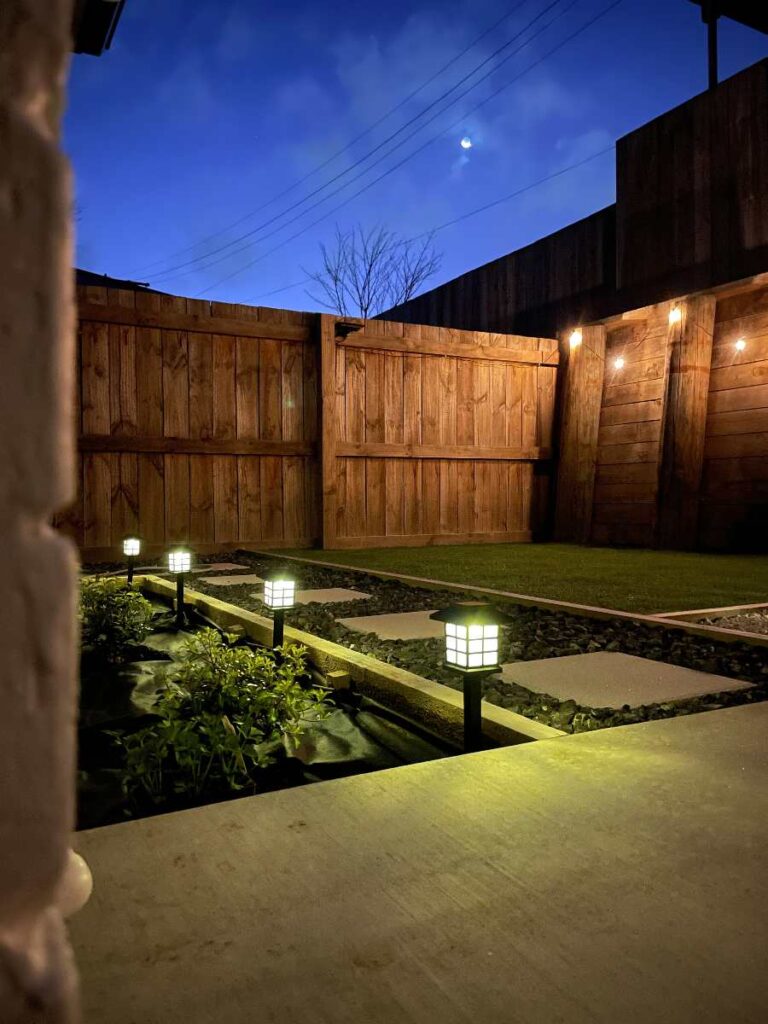
Will Japanese Plants Grow in an Australian Garden
Australia’s environment can actually suit a range of Japanese plants. Many Australian botanical gardens will have a Japanese garden section. This is the best way to learn which types of plants grow well in your area. If you’re a Brisbane local, we recommend checking out the Japanese Garden in mt Coot-Tha. It’s an awesome place to gather inspiration.
What plants should I use?
Bamboo, moss, and flowering shrubs like azaleas are perfect for a Japanese garden. Bamboo is an ideal choice for creating natural dividers and adding height. Moss helps achieve a minimalist feel and azaleas provide seasonal colour. Other options include Japanese maple, camellia and rhododendron.
What features should I include?
A small pond or water feature is a must for a zen garden patio. You’ll also want features like stone lanterns, pagodas, statues and a winding pathway. A wooden deck or pergola helps frame the space. Consider a small bridge over your pond or stream to complete the look.
What about gravel or rocks?
Raked gravel and large stones are essential for a zen garden. The gravel represents the sea or a Zen lake. The stones symbolise mountains and islands. You can create patterns in the gravel to enhance the meditative quality. Bury about two-thirds of larger stones in the gravel so they look naturally placed.
How much space do I need?
You don’t need a large space for a zen garden patio. Even a small courtyard, balcony or deck can work. The key is keeping the layout simple and uncluttered. Limit the number of features and plant species you include based on your square footage. Aim for an asymmetrical and balanced design for the most natural look in a compact space.
With the right elements and minimalist approach, you can achieve a peaceful Japanese-inspired space no matter the size of your yard or garden. Start with a rough plan but be willing to make changes as you go to create a patio that flows and inspires tranquilly.
Achieving a Japanese Aesthetic With Australian Patio Styles
To bring a touch of Japan to your outdoor space, focus on minimalism, natural materials and incorporating symbolic elements.
Minimalism is Key
A clutter-free, minimal design is essential for a Japanese-inspired patio. Remove excess furniture and decor, leaving only a few, carefully chosen pieces. A single bamboo bench, stone water feature or lantern can create an atmosphere of tranquilly.
Natural Materials
Use natural, organic materials like stone, wood and bamboo. Sandstone or slate pavers underfoot, a wooden pergola overhead and bamboo fencing provide natural textures. Pot plants in unglazed terracotta pots and include a stone water feature if space allows. These materials blend into the garden, emphasising the connection between indoor and outdoor spaces.
Conclusion
So there you have it, everything you need to know to bring a little Japanese zen into your own backyard. With some strategic plant choices, the right accents, and a focus on minimalism and natural materials, you can create an oasis of calm right at home. Don’t be afraid to start small and build over time. The journey is just as rewarding as the destination. Focus on quality over quantity, and don’t forget the all-important water feature to complete the look. Now all that’s left is to pour yourself some green tea, kick back on the new patio, and soak up the tranquilly you’ve created. Who knew a taste of Japan was so close at hand? This could be the start of a beautiful new backyard tradition.

